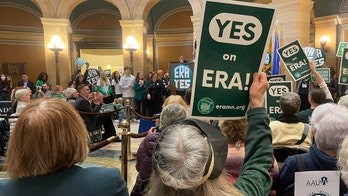Super Tuesday: What you need to know
Everything you need to know about Super Tuesday, where the candidates stand and how many delegates are at stake
FOX News First: March 1
By Chris Stirewalt
PRESENTING YOUR SUPER TUESDAY FIELD GUIDE
Is this the end of the beginning or the beginning of the end? That’s what Republican voters in 11 states will decide today as they head to the polls and caucuses to determine whether they are content with their frontrunner, Donald Trump, or ready to shake things up.
The only state of the 11deciding today in which Trump does not lead pre-election polls is Texas, where favorite son, Sen. Ted Cruz, seems to have the edge. But elsewhere, it looks like Trump by a mile. In some spots where blue-collar white voters dominate, like Alabama and Massachusetts, Trump’s lead in some polls crosses into the stratosphere.
Overall, however, the shape of the race in the Super Tuesday states looks more like what we saw in Iowa and South Carolina: Trump is ahead but Sens. Marco Rubio and Cruz are within hailing distance and splitting up half of the vote or so.
Let’s consider some scenarios:
Say goodnight - If Donald Trump has been helped rather than hurt by the sustained attacks on his business record and character by Cruz and Rubio, and if the Republican electorate has really accommodated itself to the idea of the celebrity billionaire as its standard bearer, it could all be over by midnight. Should Trump win all 11 contests or dominate 10 and come close in Texas, you can go ahead and call him the presumptive nominee.
A longer road - Past could be prologue for today’s contest, and that’s still good news for Trump overall. If the polls are predictive, which they have mostly been so far, then Trump’s advantage is in the limited success of his rivals. If Trump wins 40 percent of the nearly 600 delegates on the table, but Cruz and Rubio remain knotted behind him, then Trump would continue to march on to victory. It would take longer, but a split decision in the rest of the party would mean continued division and possibly even the continued candidacies of Gov. John Kasich and Ben Carson. This is the one in which we hear a lot of palaver about a brokered convention.
Reset button - It’s only as late in the game as Republican voters think it is. Trump triumphalism, greeted by cheers in some quarters and baleful tears in others, is a state of mind. While nearly a quarter of delegates are on the table today, 71 percent of all delegates will still be untouched on Wednesday morning. There are more delegates available in the two weeks after today, many in winner-take-all contests, than in every contest so far. If Republicans are getting cold feet about Trump and he is losing some of his luster, today could be the hinge on the gate that swings the election into a new phase. Rubio needs a moon shot to pull this off, but that could begin tonight.
[Watch Fox: The AEHQ team is at it again with Megyn Kelly and Bret Baier teaming up for another primary day special starting tonight at 6 p.m. ET through the night as the results come in.]
POWER PLAY: SUPER TUESDAY SUPER STATES
There are a lot of states voting today and with so many possible scenarios who knows what could happen? Chris Stirewalt breaks down the key counties and states to watch today that could give you the inside scoop as the results are tallied tonight. WATCH HERE.
THE LAY OF THE LAND
Here’s your state-by-state guide to the Super Tuesday votes with the key counties to watch. Have fun and stay tuned!
TEXAS
There are two contests in Texas for the Republicans: One for pride and the other for delegates. Cruz hopes to win both, and will be counting on his neighbors in the Houston metro area to deliver it for him. But Trump should find plenty of good drilling in the vast countryside where lower-income voters dominate. Rubio will be looking to scoop up some delegates from suburban Houston, Dallas, San Antonio, and Austin. Even a respectable third-place finish in Texas could still net as many delegates as were awarded in Nevada last week.
--155 delegates
--108 delegates from the state’s 36 congressional districts, three per district (outright majority wins all three district delegates, plurality win gets two, with one for the runner-up)
--47 at-large delegates based on statewide results (outright majority win receives all at-large delegates, if two candidates receive 20 percent or more the delegates will be allocated proportionally, if no one receives 20 percent delegates are awarded proportionally)
--Open primary
--7,999,657 ballots cast in 2012
--Mitt Romney, 69 percent; Ron Paul, 12 percent; Rick Santorum, 8 percent; Newt Gingrich, 5 percent
--Polls close at 8 p.m. ET
Harris County: Houston is Cruz Country
Cruz’s electoral base is right in the densest concentration of Republican votes in the state of Texas. The simplest way for him to win is to just run up the score on his home turf.
--Population: 4,441,370
--Median household income: $53,148
--Unemployment: 5 percent
--Race: Caucasian, 71 percent; Hispanic, 42 percent
--Adults with bachelor’s degree: 28 percent
--Residents age 65 or older: 9 percent
--2012 general election: Obama 49 percent
--Note: Most populous county in Texas; fourth most populous county in the U.S.
[2012 Republican Primary: Mitt Romney, 69 percent; Ron Paul, 13 percent; Rick Santorum, 7 percent; Newt Gingrich, 5 percent]
Dallas County: A milder picante
Like other large to midsize cities in Texas, the more affluent suburbs of Dallas County could prove fruitful for Rubio, even if he does not win the overall metropolitan area. Rubio could steal some votes here and maybe even carry a congressional district. That could help him get out Texas with his boots on.
--Population: 2,518,638
--Median household income: $49,481
--Unemployment: 5 percent
--Race: Caucasian, 68 percent; black, 23 percent
--Adults with bachelor’s degree: 29 percent
--Residents age 65 or older: 10 percent
--2012 general election: 57 percent
[2012 Republican Primary: Mitt Romney, 72 percent; Ron Paul, 10 percent; Rick Santorum, 8 percent; Newt Gingrich, 5 percent]
Randall County: Trump’s America
The best news for Donald Trump in Texas is the sheer size of the Lone Star State. While Texas is dominated by four huge metropolitan areas, there are dozens of what would be considered small to medium size cities in ordinary states. Those places include cities like Amarillo with a population of about 200,000, most of which is in Randall County.
--Population: 128,220
--Median household income: $58,529
--Unemployment: 3 percent
--Race: Caucasian, 93 percent; Hispanic, 20 percent
--Adults with bachelor’s degree: 30 percent
--Residents age 65 or older: 14 percent
--2012 general election: Romney 83 percent
[2012 Republican Primary: Mitt Romney, 72 percent; Rick Santorum, 10 percent; Ron Paul, 8 percent; Newt Gingrich, 4 percent]
GEORGIA
The Peach State is the biggest unknown today, not in the sense that its outcome is a mystery – Trump should win first place handily – but in how the rest of its vote will break out and how large Trump’s lead will be. Trump has consistently held between 30 and 40 percent of the vote in polls recently, but Rubio and Cruz have shown strength and durability behind him.
--76 delegates, bound
--42 are awarded from the state’s 14 congressional districts, three per district (outright majority wins all three district delegates, plurality win gets two, with one for the runner-up)
--34 at-large delegates based on statewide results (20 percent threshold)
--Open primary
--3,908,369 ballots cast in 2012
--Newt Gingrich, 47 percent; Mitt Romney, 26 percent; Rick Santorum, 20 percent; Ron Paul, 7 percent
--Polls close at 7 p.m. ET (Note: polling places with a population of more than 300,000 will be open until 8 p.m. ET)
Fulton County: Trump’s test
While the outer suburbs of Atlanta are happy Trump territory, close-in suburbs with affluent and better educated voters will be his proving ground. If Trump can win with Republicans and crossover Democrats in tony sections like Buckhead and other places inside the I-285 Beltway, he will be on his way to a romp. Conversely if Rubio shows that more moderate Republicans are rallying to his banner as they did for Mitt Romney four years ago, Georgia could be the start of the turnaround for the race.
--Population: 996,319
--Median household income: $58,857
--Unemployment: 9 percent
--Race: Caucasian, 48 percent; black 44 percent
--Adults with bachelor’s degree: 48 percent
--Residents age 65 or older: 10 percent
--2012 general election: Obama 64 percent
[2012 Republican Primary: Mitt Romney, 47 percent; Newt Gingrich, 32 percent; Rick Santorum, 12 percent; Ron Paul, 8 percent]
Bartow County: Appalachian spring
The lesson learned about Trump’s support from the South Carolina Primary is that it is most intense in places where incomes are low and white voters live alongside large minority populations. But we also learned that support for Cruz and Rubio was stronger in Appalachia. And North Georgia has plenty of Appalachia. While Trump can be expected to dominate smaller communities in the south and east, places like Cartersville in Bartow County a third of the way to the Tennessee State Line from Atlanta, could be good for Cruz and Rubio.
--Population: 101,736
--Median household income: $47,197
--Unemployment: 8 percent
--Race: Caucasian, 86 percent; black, 11 percent
--Adults with bachelor’s degree: 16 percent
--Residents age 65 or older: 13 percent
--2012 general election: Romney 75 percent
[2012 Republican Primary: Newt Gingrich, 56 percent; Rick Santorum, 19 percent; Mitt Romney, 18 percent; Ron Paul, 6 percent]
VIRGINIA
If Rubio is really a viable contender, Virginia is where he will show it. It is a blue-hued swing state with lots of upscale suburbanites, well-educated voters and moderate Republicans. But conversely, if he can’t do well here the idea of a Rubio stretch run will run out of gas.
--49 delegates
--All delegates awarded proportionally based on statewide results with no threshold
--Open primary
--3,854,489 ballots cast in 2012
---Mitt Romney, 60 percent; Ron Paul, 40 percent
--Polls close at 7 p.m. ET
Fairfax County: Club Fed
One of the wealthiest counties in America, Fairfax County is home to people who feel the very best about the federal government. The so-called “Beltway Bandits” who have prospered with fine federal jobs or fat federal contracts live here. Though overwhelmingly Democratic since the 1990s, by sheer size, Fairfax is still home to lots of Republicans. Like the cluster of counties that surround it this should be good territory for Rubio, but he needs to be on the lookout for John Kasich. If Kasich’s spoiler campaign is going to hurt Rubio anywhere it will be among the centrist, government enthusiasts of NoVa.
--Population: 1,137,538
--Median household income: $110,292
--Unemployment: 4 percent
--Race: Caucasian, 67 percent; Hispanic, 16 percent
--Adults with bachelor’s degree: 59 percent
--Residents age 65 or older: 12 percent
--2012 general election: Obama 60 percent
[2012 Republican Primary: Mitt Romney, 65 percent; Ron Paul, 35 percent]
Albemarle County: Wahoobio?
One of the reasons that Marco Rubio can be cautiously optimistic about his chances in Virginia is the sustained growth of Charlottesville and the University of Virginia. Previous elections saw only three centers of population in the state: The dense suburbs of Northern Virginia, Richmond and its environs, and the industrial Tidewater region. But Charlottesville offers a surprising number of votes and, if other affluent university towns so far this cycle are a guide, fecund ground for Rubio.
--Population: 104,489
--Median household income: $67,725
--Unemployment: 3 percent
--Race: Caucasian, 83 percent; black 10 percent
--Adults with bachelor’s degree: 52 percent
--Residents age 65 or older: 17 percent
--2012 general election: Obama 55 percent
[2012 Republican Primary: Mitt Romney, 62 percent; Ron Paul, 38 percent]
OKLAHOMA
Why isn’t Trump doing better in Oklahoma polls? The state matches his demographic profile: white, ranked 42nd in adults with college degrees and 41st in median household income. But instead of the Trump smash being forecast in some other similar-seeming states, polls show Trump only 10 points or so ahead. There are a few possible explanations including the expansive, though recently arrested, success of the natural gas industry. But more likely it is this: Oklahoma may be the most politically conservative state in America. The Sooner State sent fiscal disciplinarian “Dr. No,” Tom Coburn (now boosting Rubio) to Congress for as long as he wanted.
--43 delegates
--15 congressional district delegates, three for each of the 5 districts (outright majority win receives all congressional delegates, top three finishers get one delegate each if they receive above 15 percent of the voter)
--28 at-large delegates based on statewide results (outright majority win receives all at-large delegates, if candidates receive 15 percent or above the delegates will be allocated proportionally)
--Closed primary
--1,334,872 ballots cast in 2012
--Rick Santorum, 34 percent; Mitt Romney, 28 percent; Newt Gingrich, 27 percent; Ron Paul, 10 percent
--Polls close at 8 p.m. ET
Oklahoma County: Almost all the marbles
Oklahoma City was a boomtown and is still a hub for the region. It’s fast growing southern suburbs, including Moore, ought to see a fairly close split between Rubio and Cruz.
--Population: 766,215
--Median household income: $45,215
--Unemployment: 3 percent
--Race: Caucasian, 71 percent; black, 16 percent
--Adults with bachelor’s degree: 30 percent
--Residents age 65 or older: 13 percent
--2012 general election: Romney 58 percent
[2012 Republican Primary: Mitt Romney, 34 percent; Rick Santorum, 31 percent; Newt Gingrich, 23 percent; Ron Paul, 11 percent]
ALABAMA
TRUUUUUUUUUUUUUUUUUUUUUUUUUUMP!
--50 delegates
--21 district delegates three delegates for each of the seven counties (outright majority or the only candidate with over 20 percent receives all congressional delegates, if more than one candidate receives 20 percent the candidate with the most votes gets two delegates and the runner up gets one delegate)
--29 at-large delegates based on statewide results (outright majority or above a 20 percent win receives all at-large delegates, if no one reaches that mark delegates will be allocated proportionally to those finishing above 20 percent)
--Open primary
--2,074,338 ballots cast in 2012
--Rick Santorum, 35 percent; Newt Gingrich, 29 percent; Mitt Romney, 29 percent; Ron Paul, 5 percent
--Polls close at 8 p.m. ET (Note: Some polling places in Alabama are in the Eastern Time zone and close at 7 p.m. ET while others in the Central Time zone close at 8 p.m. ET)
Mobile County: Coastal elite
While there is a large blue-collar population on Alabama’s Gulf Coast it is also home to some of the state’s most affluent, upscale voters. The most votes can be found around Birmingham and Jackson, this demographically split portion of the state offers some interesting wrinkles. But it’s probably Trump, the whole Trump and nothing but the Trump.
--Population: 415,123
--Median household income: $43,028
--Unemployment: 7 percent
--Race: Caucasian, 60 percent; black, 35 percent
--Adults with bachelor’s degree: 21 percent
--Residents age 65 or older: 15 percent
--2012 general election: Romney 54 percent
[2012 Republican Primary: Mitt Romney, 36 percent; Rick Santorum, 34 percent; Newt Gingrich, 24 percent; Ron Paul, 5 percent]
ARKANSAS
In the greatest film ever set in Arkansas, John Wayne’s “True Grit,” Marshal Rooster Cogburn tells the outlaw Ned Pepper that he means to kill him in “one minute,” or see him hanged in Fort Smith. Pepper, played by Robert Duval, looks at Cogburn’s paunch and declares, “I call that bold talk for a one-eyed fat man.” You can tell the same to anyone who pretends to know what will happen in the Arkansas Republican Primary.
--40 delegates
--12 district delegates, three for each of the state’s four congressional districts (outright majority win receives all the district delegates, if no candidate receives a majority of the vote the candidate with the plurality receives two delegates and the runner up receives one)
--28 at-large delegates based on statewide results (each candidate with 15 percent or more receives one delegate and the candidate with the majority receives the rest, if no candidate has a statewide majority the remaining delegates are awarded proportionally to those above 15 percent of the vote)
--Closed primary
--1,069,468 ballots cast in 2012
--Mitt Romney, 68 percent; Ron Paul, 13 percent; Rick Santorum, 13 percent; Newt Gingrich, 5 percent
--Polls close at 8:30 p.m. CST
Pulaski County: Two stories
There are two ways to look at Arkansas’ capital, Little Rock, and its county, Pulaski. On one hand, it looks like Trump country, where lots of blue-collar white voters live in close proximity to a significant number of minorities. But it’s also a capital city where there are plenty of upscale voters. There’s a decent chance that the three frontrunners will come out essentially even.
--Population: 392,701
--Median household income: $46,013
--Unemployment: 5 percent
--Race: Caucasian, 59 percent; black 36 percent
--Adults with bachelor’s degree: 31 percent
--Residents age 65 or older: 14 percent
--2012 general election: Obama 55 percent
[2012 Republican Primary: Mitt Romney, 71 percent; Ron Paul, 13 percent; Rick Santorum, 12 percent; Newt Gingrich, 4 percent]
Benton County: Company town
Politicians in both parties have spent more than a decade pursuing the elusive “Walmart voter.” Well, here’s your chance. The corporate headquarters of America’s largest private employer is here in Bentonville and it is among the most prosperous places in a region not known for its prosperity. This county in the northwest corner of the state could be a hidden gem for Rubio.
--Population: 242,321
--Median household income: $54,515
--Unemployment: 4 percent
--Race: Caucasian, 90 percent; black 2 percent
--Adults with bachelor’s degree: 29 percent
--Residents age 65 or older: 13 percent
--2012 general election: Romney 70 percent
[2012 Republican Primary: Mitt Romney, 65 percent; Rick Santorum, 16 percent; Ron Paul, 15 percent; Newt Gingrich, 5 percent]
TENNESSEE
You can divide Tennessee into three distinct regions: The Appalachian east, the Cumberland Valley around Nashville in the center, and the Memphis sprawl in the west. The eastern side of the state around Knoxville should be revealing about the relative strengths about Rubio and Cruz. Like the rest of the region, the population and economic center of metro Knoxville should be better for the two senators than elsewhere. The battle and most of the votes, however, will be to the west.
--58 delegates
--27 district delegates three from each of the nine congressional districts (candidate with either 67 percent majority in the district wins all three delegates, if no one reaches that mark candidates with the highest percent of the vote receive two delegates and the runner up gets one delegate so long as they have above 20 percent of the vote)
--31 at-large delegates based on statewide results (candidate with 67 percent of the vote receives all at-large delegates, otherwise delegates are distributed proportionally to those with 20 percent of the vote)
--Open primary
--2,460,904 ballots cast in 2012
--Rick Santorum, 37 percent; Mitt Romney, 28 percent; Newt Gingrich, 24 percent; Ron Paul, 9 percent
--Most polls close at either 7 or 8 p.m. ET (Polls closings vary by county and are split between Eastern and Central time zones)
Williamson County: Moderate twang
You probably think of Nashville as Music City. But if you live in Tennessee, you think of it as the state capital, and a large, growing, affluent city that is home to Vanderbilt University and multiple corporate headquarters. As the county stretches out to the south, however, it takes in more blue-collar voters on the other side of Franklin. Like the Northern Virginia suburbs, if Marco Rubio is a contender for 2016 he will do well in Williamson County.
--Population: 205,226
--Median household income: $89,779
--Unemployment: 4 percent
--Race: Caucasian, 90 percent; black 5 percent
--Adults with bachelor’s degree: 53 percent
--Residents age 65 or older: 12 percent
--2012 general election: Romney 73 percent
[2012 Republican Primary: Mitt Romney, 36 percent; Rick Santorum, 32 percent; Newt Gingrich, 23 percent; Ron Paul, 8 percent]
Shelby County: Trump smokes ‘em
There’s a lot to like about Memphis and its main suburban county, particularly the blues and barbeque. But if you are Donald Trump there’s even more. The county has some wealthy enclaves, but is dominated in Republican politics by his kind of voter.
--Population: 938,803
--Median household income: $46,250
--Unemployment: 6 percent
--Race: Caucasian, 42 percent; black, 53 percent
--Adults with bachelor’s degree: 29 percent
--Residents age 65 or older: 12 percent
--2012 general election: Obama 63 percent
[2012 Republican Primary: Rick Santorum, 37 percent; Mitt Romney, 34 percent; Newt Gingrich, 19 percent; Ron Paul, 8 percent]
MASSACHUSETTS
If you thought New Hampshire liked Donald Trump, you ain’t seen nothin’ yet. With the same primary setup as New Hampshire that allows independents to vote, a lot of fed-up, blue-collar voters and no particular bent towards conservativism, Massachusetts is maximum Trump. He may get enough votes in Middlesex County alone to carry the state’s primary. Middlesex is the broad swap of urban sprawl on the north side of Boston, part of which was once represented by Trump endorser former Sen. Scott Brown.
--42 delegates
--27 district delegates three for each of the state’s nine congressional districts
--15 at-large delegates
--All delegates allocated proportionally based on statewide results with a five percent threshold
--Mixed primary (Republicans and independents can vote in the GOP primary, but not Democrats)
--3,167,767 ballots cast in 2012
--Mitt Romney, 93 percent; Unallocated, 7 percent
--Polls close at 8 p.m. ET
Middlesex County:
--Population: 1,570,315
--Median household income: $82,090
--Unemployment: 4 percent
--Race: Caucasian, 81 percent; Hispanic, 8 percent
--Adults with bachelor’s degree: 51 percent
--Residents age 65 or older: 14 percent
--2012 general election: Obama 63 percent
[2012 Republican Primary: Mitt Romney, 75 percent; Rick Santorum, 10; Ron Paul 10 percent; Newt Gingrich, 4 percent]
MINNESOTA
Like their neighbors to the south in Iowa, Minnesotans go to caucus to pick their presidential nominees. And that makes things weird. Rick Santorum carried the state in 2012 as he was gamely chasing Romney, even though Minnesota didn’t demographically match Santorum’s other successful areas. The only poll taken this year showed Rubio slightly ahead of Cruz and Trump at the end of January. But who the heck knows? Organization is the key in these small-turnout affairs. Trump showed he could deliver in Nevada, so keep your eyes on the North Star State. Most of the vote will come from Hennepin County in the suburbs of Minneapolis.
--38 delegates
--Candidate with 85 percent or more receives all 38 delegates
--24 district delegates, three from each of the state’s eight districts, will be awarded proportionally to those with a mandatory 10 percent threshold within the district
--14 at-large delegates based on statewide results to those with a mandatory 10 percent threshold
--Open caucus
--2,936,561 ballots cast in 2012
--Rick Santorum, 45 percent; Ron Paul, 27 percent; Mitt Romney, 17 percent; Newt Gingrich, 11 percent
--Polls close at 9 p.m. ET
Hennepin County:
--Population: 1,212,064
--Median household income: $64,403
--Unemployment: 3 percent
--Race: Caucasian, 76 percent; black 13 percent
--Adults with bachelor’s degree: 46 percent
--Residents age 65 or older: 13 percent
--2012 general election: Obama 62 percent
[2012 Republican Primary: Mitt Romney, 23 percent; Newt Gingrich, 10 percent]
ALASKA
Where the heck has Sarah Palin been? After a few days on the trail with her candidate Trump, we haven’t heard much from the former Alaska governor. But presumably she should be able to deliver her home state for him. Trump and Palin, however, must beware of the wide streak of establishment Republicanism that runs through Alaska. Even so, the last frontier ought to come in late, but heavy for Trump. Keep your eyes on Mantanuska-Susitna Borough -- the heart of the “Mat-Su Valley” -- that’s where almost all the votes will be.
--28 delegates
--Delegates allocated proportionally with a mandatory 13 percent threshold statewide
--Closed caucus
--300,495 ballots cast in 2012
--Mitt Romney, 32 percent; Rick Santorum, 30 percent; Ron Paul, 24 percent; Newt Gingrich, 13 percent
--Polls close 12 a.m. (March 2nd)
Mantanuska-Susitna Borough:
--Population: 97,882
--Median household income: $71,037
--Unemployment: 8 percent
--Race: Caucasian, 84 percent; black, 1 percent
--Adults with bachelor’s degree: 21 percent
--Residents age 65 or older: 10 percent
--2012 general election: Romney 55 percent
[2012 Republican Primary: Mitt Romney, 32 percent; Rick Santorum, 30 percent; Ron Paul, 24 percent; Newt Gingrich, 13
percent]
VERMONT
We have talked many times this election cycle about the surprising number of voters torn between Trump and Vermont’s socialist Sen. Bernie Sanders. While that split was helpful for Trump in neighboring New Hampshire and will be in Massachusetts today, it’s not likely to do much good for Trump in Sanders’ home state. The Green Mountains should fairly ring with the chants of “Feel the Bern!” That won’t leave many disaffected independents for Trump. But there still might be enough. The state’s Republicans tend to have a strong libertarian streak and are social moderates. While Rubio could be expected to do fine here, never count Trump out in the Northeast. The place to watch, not surprisingly, is Burlington’s county: Chittenden.
--16 delegates
--Three district delegates for the state’s single congressional district will be allocated proportionally if no candidate wins 50 percent, but candidates must win at least 20 percent of the vote statewide to receive any district delegates
--13 at-large delegates will be awarded proportionally to the candidates with a 20 percent threshold statewide
--Candidate with 50 percent statewide majority receives all delegates
--Open primary
--299,290 ballots cast in 2012
--Mitt Romney, 39 percent; Ron Paul, 25 percent; Rick Santorum, 24 percent; Newt Gingrich, 8 percent
--Polls close at 7 p.m. ET
Chittenden County:
--Population: 160,531
--Median household income: $63,989
--Unemployment: 4 percent
--Race: Caucasian, 91 percent; black, 2 percent
--Adults with bachelor’s degree: 47 percent
--Residents age 65 or older: 13 percent
--2012 general election: Obama 70 percent
[2012 Republican Primary: Mitt Romney, 41 percent; Ron Paul, 25 percent; Rick Santorum, 23 percent; Newt Gingrich, 7 percent]
Chris Stirewalt is digital politics editor for Fox News. Want FOX News First in your inbox every day? Sign up here.





